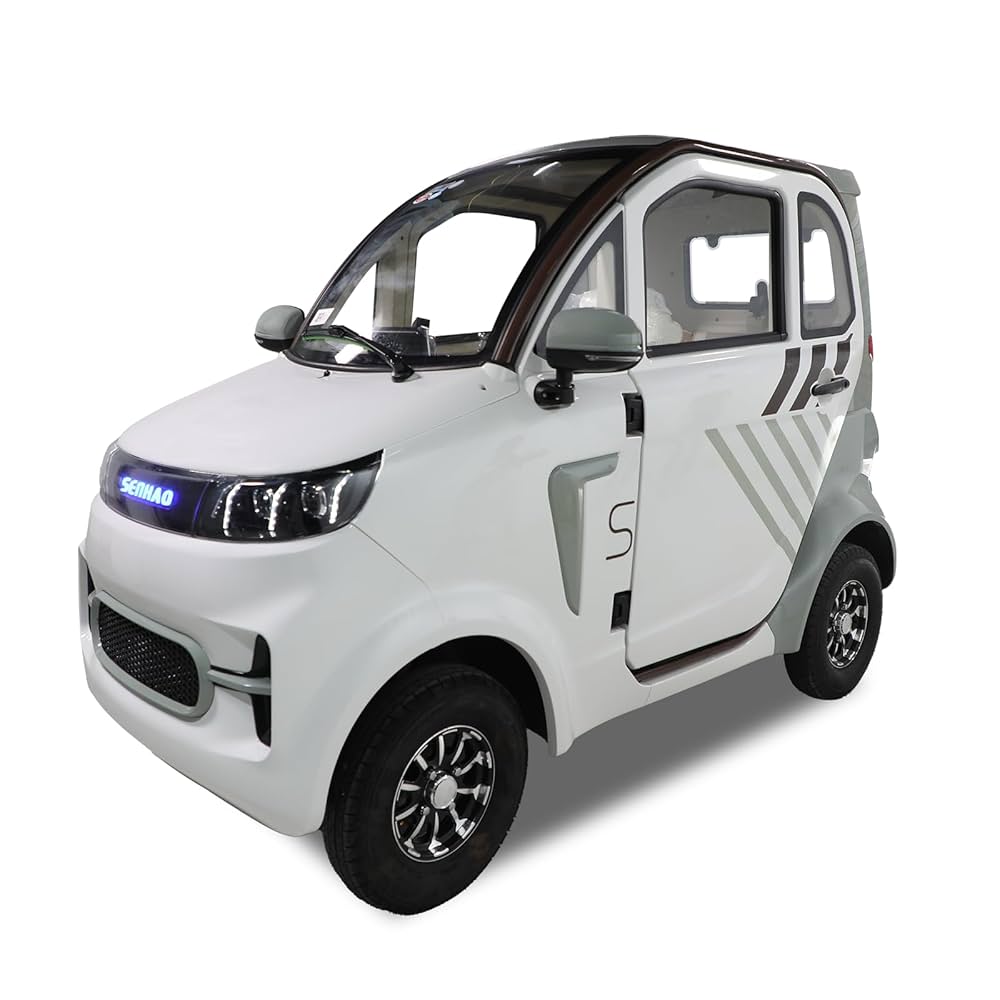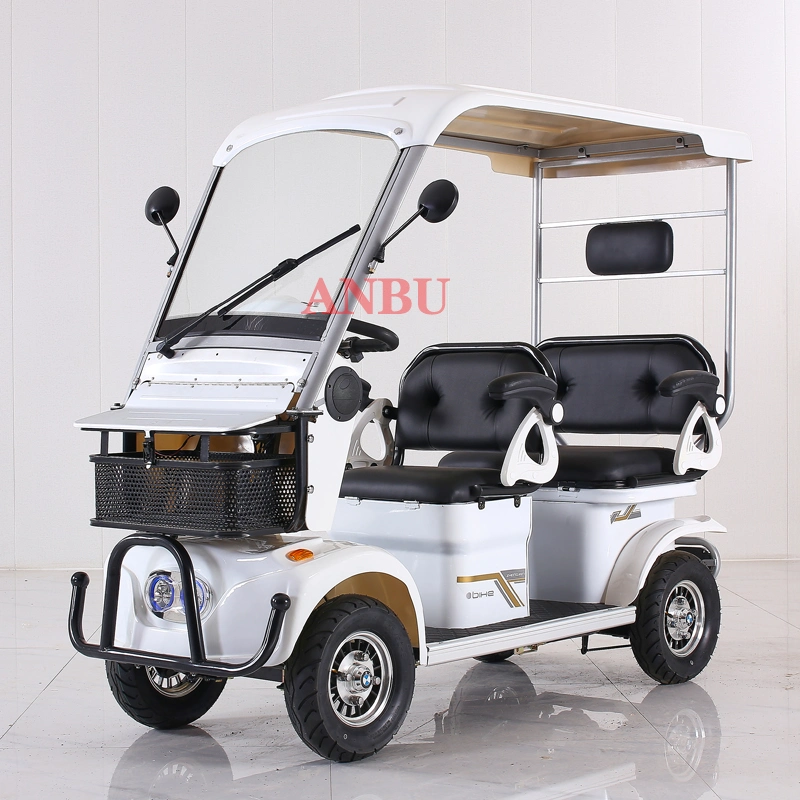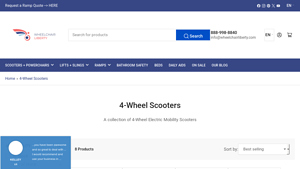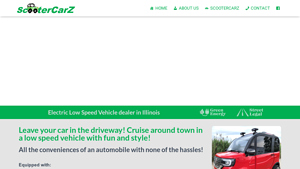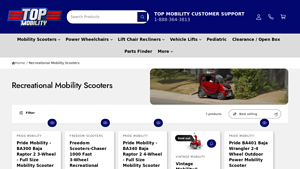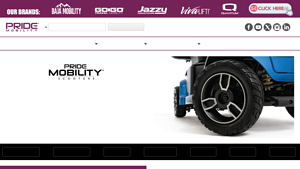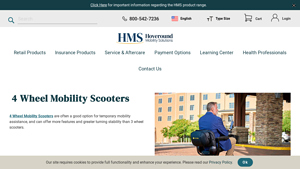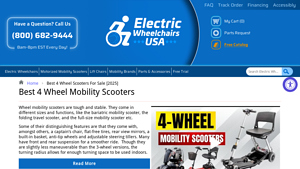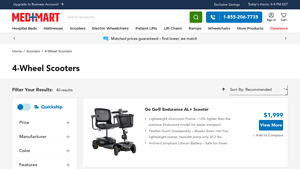Introduction: Navigating the Global Market for 4 wheel electric scooter car for adults
In the rapidly evolving landscape of mobility solutions, sourcing the right 4-wheel electric scooter car for adults presents a unique challenge for international B2B buyers. With a diverse range of options available, from heavy-duty models designed for rugged terrains to compact designs ideal for urban environments, understanding the nuances of these vehicles is crucial. This guide serves as a comprehensive resource, exploring various types of scooters, their applications across different markets, and essential considerations for supplier vetting.
International buyers, particularly those in Africa, South America, the Middle East, and Europe—including key markets like Germany and Brazil—will find actionable insights on pricing, features, and performance metrics. By addressing critical questions about weight capacity, battery life, and safety features, this guide empowers businesses to make informed purchasing decisions that align with their operational needs and customer expectations.
Navigating the global market for 4-wheel electric scooters is not merely about finding a product; it’s about understanding the broader implications of mobility solutions in enhancing quality of life, ensuring accessibility, and promoting sustainable transportation. As demand for reliable and efficient mobility options grows, leveraging this guide will enable B2B buyers to select the right products that meet their specific market requirements and customer preferences.
Understanding 4 wheel electric scooter car for adults Types and Variations
| Type Name | Key Distinguishing Features | Primary B2B Applications | Brief Pros & Cons for Buyers |
|---|---|---|---|
| All-Terrain Scooters | Enhanced suspension, rugged tires, higher weight capacity | Outdoor recreation, tourism, rental services | Pros: Versatile for various terrains; durable. Cons: Heavier and may be pricier. |
| Bariatric Mobility Scooters | Higher weight capacity (up to 500 lbs), reinforced structure | Healthcare, rehabilitation centers | Pros: Supports larger users; stable. Cons: Limited model variety; bulkier design. |
| Folding Mobility Scooters | Compact design, lightweight, easy to transport | Travel, urban commuting, retail environments | Pros: Portable; space-saving. Cons: Smaller battery; may have lower weight capacity. |
| Heavy-Duty Scooters | Robust build, high weight limits, advanced features | Industrial applications, warehouses | Pros: Suitable for demanding environments; reliable. Cons: Higher cost; less maneuverable. |
| Low-Speed Electric Vehicles (LSEVs) | Car-like features, enclosed design, street-legal | Urban transport, commercial use | Pros: Comfortable for longer trips; versatile. Cons: Regulatory restrictions; higher initial investment. |
What Are All-Terrain Scooters and Their B2B Relevance?
All-terrain scooters are designed for rugged outdoor use, featuring advanced suspension systems and durable tires that can handle various terrains. They are ideal for businesses involved in outdoor recreation, such as tour operators or rental services, as they can provide customers with a reliable means of transportation in challenging environments. When purchasing, B2B buyers should consider the scooter’s weight capacity, battery life, and maintenance needs, ensuring that they align with the demands of their clientele.
How Do Bariatric Mobility Scooters Serve Specific Markets?
Bariatric mobility scooters cater to users with higher weight requirements, offering reinforced structures and increased stability. These scooters are particularly valuable in healthcare settings, such as rehabilitation centers and nursing homes, where accommodating larger patients is essential. Buyers should evaluate the weight capacity, comfort features, and ease of access when selecting models, as these factors significantly influence user satisfaction and safety.
What Advantages Do Folding Mobility Scooters Offer for Urban Use?
Folding mobility scooters are compact and lightweight, making them perfect for urban environments where space is limited. They are especially suitable for businesses targeting travelers or city dwellers who need a portable solution for mobility. When considering a purchase, B2B buyers should assess the scooter’s folding mechanism, battery range, and overall durability to ensure it meets the needs of their customers effectively.
Why Choose Heavy-Duty Scooters for Industrial Applications?
Heavy-duty scooters are built to withstand rigorous use, featuring robust designs and higher weight limits. They are ideal for industrial applications, such as warehouses or large retail spaces, where mobility solutions must endure frequent use and transport heavier loads. Buyers should focus on the scooter’s stability, battery efficiency, and maintenance requirements, as these attributes are crucial for long-term operational success.
What Are the Benefits of Low-Speed Electric Vehicles (LSEVs) in Commercial Settings?
Low-speed electric vehicles (LSEVs) provide a blend of mobility and comfort, equipped with car-like features and often designed for street use. They are increasingly popular in urban transport and commercial applications, such as hotels or large campuses. B2B buyers should consider local regulations, charging infrastructure, and overall cost when investing in LSEVs, as these factors will impact their operational viability and customer satisfaction.
Key Industrial Applications of 4 wheel electric scooter car for adults
| Industry/Sector | Specific Application of 4 Wheel Electric Scooter Car for Adults | Value/Benefit for the Business | Key Sourcing Considerations for this Application |
|---|---|---|---|
| Healthcare | Patient transport within hospitals and care facilities | Enhances mobility for patients with limited mobility, reducing strain on staff and improving patient experience. | Ensure weight capacity meets patient needs and consider battery life for extended use. |
| Tourism and Leisure | Accessible transportation for tourists in parks and attractions | Provides a convenient and eco-friendly option for navigating large venues, enhancing visitor experience. | Look for models with comfort features and high maneuverability for diverse terrains. |
| Retail and Warehousing | In-store mobility for employees and customers | Improves efficiency in large retail spaces, allowing for quicker service and enhanced customer experience. | Consider models with adequate storage space and durability for frequent use. |
| Municipal Services | Community transport for elderly and disabled residents | Facilitates greater independence and mobility for citizens, fostering inclusivity in community planning. | Evaluate local regulations for electric vehicles and necessary safety features. |
| Agriculture | Transporting goods and personnel across large farms | Increases operational efficiency by providing a reliable means of transport in expansive agricultural settings. | Assess terrain adaptability and battery performance to ensure reliability in rural areas. |
How Are 4 Wheel Electric Scooter Cars Used in Healthcare Settings?
In healthcare facilities, 4 wheel electric scooter cars serve as an essential mode of transportation for patients with mobility challenges. They facilitate easy movement between different departments, ensuring that patients can access necessary care without exhausting themselves or relying heavily on staff assistance. For international buyers, particularly in regions with aging populations like Europe and South America, sourcing models with higher weight capacities and longer battery life is crucial to accommodate diverse patient needs and ensure reliable operation throughout the day.
What Role Do 4 Wheel Electric Scooter Cars Play in Tourism and Leisure?
In the tourism sector, 4 wheel electric scooter cars are increasingly used to enhance the experience of visitors at parks, resorts, and attractions. These scooters allow tourists to navigate large areas comfortably, promoting accessibility for individuals with mobility impairments. For B2B buyers, particularly in Africa and the Middle East, it’s important to consider models that are durable and equipped with features like comfortable seating and storage options for personal belongings, ensuring a pleasant experience for tourists.
How Are 4 Wheel Electric Scooter Cars Beneficial in Retail and Warehousing?
In retail environments, 4 wheel electric scooter cars assist both employees and customers in moving around large stores or warehouses. They help in transporting goods, reducing the physical strain on staff and improving service efficiency. When sourcing these scooters, businesses should prioritize models that offer robust storage solutions and are designed for high-frequency use, ensuring they can withstand the demands of bustling retail settings, especially in densely populated areas of South America and Europe.
What Benefits Do 4 Wheel Electric Scooter Cars Offer to Municipal Services?
Municipal services utilize 4 wheel electric scooter cars to provide transportation for elderly and disabled residents, promoting independence and inclusivity in community planning. These scooters can navigate urban environments, making them ideal for cities looking to enhance accessibility. For B2B buyers in the Middle East and Europe, it is essential to ensure compliance with local regulations regarding electric vehicles, as well as to consider the safety features necessary for public use.
How Are 4 Wheel Electric Scooter Cars Used in Agriculture?
In agricultural settings, 4 wheel electric scooter cars are invaluable for transporting goods and personnel across vast fields. They enhance operational efficiency by providing a reliable means of transport, which is particularly beneficial in rural areas. Buyers from Africa and other agricultural regions should focus on models that can handle uneven terrain and offer strong battery performance to ensure they can operate effectively throughout the workday.
3 Common User Pain Points for ‘4 wheel electric scooter car for adults’ & Their Solutions
Scenario 1: Navigating Diverse Terrain Challenges with 4 Wheel Electric Scooters
The Problem: B2B buyers often face the challenge of sourcing 4 wheel electric scooters that can navigate diverse terrains, especially when catering to clients in regions with varied landscapes such as Africa or South America. Users may require scooters that can handle rugged paths, uneven surfaces, or even urban settings with curbs and potholes. The risk of choosing scooters that lack adequate suspension or robust tires can lead to user dissatisfaction and potential safety hazards.
The Solution: To address this challenge, buyers should prioritize scooters designed with all-terrain capabilities. Look for models that feature robust suspension systems and durable, puncture-resistant tires. When sourcing, request detailed specifications on the scooter’s turning radius, weight capacity, and ground clearance. Conduct field tests or seek testimonials from users in similar environments to ensure the scooters can handle the expected challenges. Additionally, consider partnering with manufacturers that provide a warranty and after-sales support, which can be invaluable for maintenance in rugged areas.
Scenario 2: Ensuring Battery Life Meets User Needs for 4 Wheel Electric Scooters
The Problem: Another common pain point for B2B buyers is the battery life of 4 wheel electric scooters. Many users are concerned about the range of scooters, especially for longer excursions or when used in commercial settings where recharging may not be immediately available. A scooter that runs out of battery mid-journey can lead to frustration and potentially leave users stranded.
The Solution: Buyers should look for scooters equipped with high-capacity batteries that offer a longer driving range, ideally exceeding 20 miles on a single charge. When evaluating options, inquire about the amperage of the batteries and the efficiency of the motor. It’s essential to choose models that feature user-friendly charging ports for quick recharges. Additionally, consider offering additional battery packs as an option for clients who require extended use, or providing education on optimal charging practices to maximize battery life.
Scenario 3: Customizing Features to Meet Diverse User Needs in 4 Wheel Electric Scooters
The Problem: Different users have varying needs and preferences, which can complicate the purchasing process for B2B buyers. Some may require added safety features like headlights and turn signals, while others might prioritize comfort features such as adjustable seating or storage solutions. The inability to customize scooters can result in lost sales or customer dissatisfaction.
The Solution: To effectively meet diverse user needs, buyers should seek suppliers that offer a range of customizable options. This includes selecting accessories like storage baskets, cup holders, and comfort upgrades such as ergonomic seating. When negotiating with manufacturers, discuss the possibility of creating tailored packages based on specific user demographics, such as seniors needing stability features or younger users seeking stylish designs. Conduct surveys or focus groups to understand the features most desired by potential users in your target markets, allowing for informed purchasing decisions that cater to specific needs.
Strategic Material Selection Guide for 4 wheel electric scooter car for adults
What Materials Are Commonly Used in 4 Wheel Electric Scooters for Adults?
When selecting materials for 4 wheel electric scooters designed for adults, several key factors must be considered, including durability, weight, cost, and compliance with international standards. Below, we analyze four common materials used in the construction of these scooters, highlighting their properties, advantages, disadvantages, and implications for international buyers.
Aluminum: A Lightweight and Corrosion-Resistant Option
Aluminum is frequently utilized in the frame and body of electric scooters due to its excellent strength-to-weight ratio and corrosion resistance. This material can withstand a range of temperatures and is relatively easy to manufacture, making it a popular choice for both structural components and aesthetic elements.
Pros: Aluminum is lightweight, which enhances the scooter’s overall performance and efficiency. It also resists rust, making it suitable for various climates, particularly in regions with high humidity or coastal environments.
Cons: While aluminum is strong, it can be more expensive than steel and may require specialized manufacturing processes. Additionally, it is less impact-resistant than some other metals, which could be a concern in rugged terrains.
Impact on Application: Aluminum’s corrosion resistance makes it ideal for outdoor use, particularly in humid or saline environments, ensuring longevity and reduced maintenance.
Considerations for International Buyers: Buyers in Africa, South America, the Middle East, and Europe should ensure that aluminum components meet relevant standards (e.g., ASTM or DIN) for safety and performance.
Steel: The Traditional Choice for Strength
Steel is another common material, particularly for structural components that require high strength and durability. It is often used in the chassis and support structures of electric scooters.
Pros: Steel is incredibly strong and durable, providing excellent structural integrity. It is also relatively low-cost compared to aluminum, making it an economical choice for manufacturers.
Cons: Steel is heavier than aluminum, which can affect the scooter’s range and efficiency. Additionally, it is prone to rust if not properly treated or coated.
Impact on Application: Steel’s durability allows it to handle heavy loads and rough terrains, making it suitable for heavy-duty scooters designed for bariatric users.
Considerations for International Buyers: Compliance with international standards for weight capacity and safety is crucial, especially in regions with varying road conditions.
Composite Materials: A Modern Solution
Composite materials, such as fiberglass or carbon fiber, are increasingly being used in electric scooters for their lightweight and strength properties. These materials can be molded into complex shapes, allowing for innovative designs.
Pros: Composites offer high strength-to-weight ratios and excellent resistance to corrosion and environmental degradation. They can also provide better aesthetics and customization options.
Cons: The manufacturing process for composites can be complex and costly. Additionally, they may not be as easily recyclable as metals, which could be a concern for environmentally conscious buyers.
Impact on Application: Composites are particularly advantageous in applications where weight savings are critical, such as in portable or folding scooters.
Considerations for International Buyers: Buyers should verify that composite materials meet international safety standards and consider the recyclability of these materials in their local markets.
Plastic: Versatile and Cost-Effective
Plastics are commonly used in the production of various components, such as body panels, dashboards, and storage compartments. They are lightweight and can be produced in various colors and finishes.
Pros: Plastics are cost-effective and can be molded into intricate shapes, allowing for creative designs. They are also resistant to corrosion and can be lightweight.
Cons: While plastics are versatile, they may not offer the same level of durability as metals or composites, particularly in high-stress applications. They can also degrade over time when exposed to UV light.
Impact on Application: The use of plastic components can reduce the overall weight of the scooter, enhancing performance and efficiency.
Considerations for International Buyers: Ensuring that plastics used comply with safety and environmental regulations in different markets is essential, especially in Europe where regulations are stringent.
Summary Table of Material Selection for 4 Wheel Electric Scooters
| Material | Typical Use Case for 4 Wheel Electric Scooter Car for Adults | Key Advantage | Key Disadvantage/Limitation | Relative Cost (Low/Med/High) |
|---|---|---|---|---|
| Aluminum | Frame and body components | Lightweight and corrosion-resistant | More expensive and less impact-resistant | Medium |
| Steel | Chassis and structural components | High strength and durability | Heavier and prone to rust | Low |
| Composite Materials | Body panels and innovative designs | High strength-to-weight ratio | Complex and costly manufacturing | High |
| Plastic | Body panels and storage compartments | Cost-effective and versatile | Less durable and UV degradation | Low |
This strategic material selection guide provides valuable insights for B2B buyers in the electric scooter market, aiding in the decision-making process for sourcing and manufacturing durable, efficient, and compliant products.
In-depth Look: Manufacturing Processes and Quality Assurance for 4 wheel electric scooter car for adults
What Are the Key Manufacturing Processes for 4 Wheel Electric Scooter Cars for Adults?
The manufacturing process for 4 wheel electric scooters involves several critical stages, ensuring the final product meets safety, performance, and durability standards. Each phase—from material preparation to finishing—plays a vital role in the overall quality of the scooter.
How is Material Prepared in the Manufacturing of Electric Scooters?
Material preparation is the first step in the manufacturing process. This phase includes sourcing high-quality materials like steel, aluminum, and plastic, which are essential for the frame and body of the scooter. Suppliers often conduct rigorous checks on these materials to ensure they meet specified standards for strength and durability.
Once materials are sourced, they undergo cutting and shaping processes. For metal components, techniques such as laser cutting and CNC machining are frequently employed to achieve precise dimensions. For plastic parts, injection molding is a common technique, allowing for efficient mass production with consistent quality.
What Forming Techniques Are Used in Manufacturing Electric Scooters?
Forming is a critical stage where raw materials are transformed into functional components of the scooter. This typically involves welding, bending, and stamping for metal parts. High-quality welding techniques, such as MIG or TIG welding, are crucial for ensuring that the frame is robust and can withstand daily usage.
For plastic components, forming methods include blow molding and thermoforming, which are essential for creating various shapes and designs. The choice of technique often depends on the specific requirements of the scooter, such as weight considerations and aesthetic preferences.
How Is Assembly Conducted for 4 Wheel Electric Scooters?
The assembly process is where all components come together to create the final product. This stage typically includes the installation of the electric motor, battery, wheels, and control systems. A systematic approach is vital during assembly to ensure all parts fit correctly and function as intended.
Manufacturers often utilize assembly lines, where workers or automated systems follow a strict sequence to enhance efficiency. Quality checks are integrated into the assembly process, where components are tested for compatibility and functionality before proceeding to the next stage.
What Finishing Techniques Are Commonly Used?
Finishing involves applying protective coatings and aesthetic enhancements to the electric scooter. This may include painting, powder coating, or galvanizing metal parts to prevent corrosion and improve durability. A well-executed finishing process not only extends the life of the scooter but also enhances its market appeal.
Labeling and branding are also part of the finishing stage, where the manufacturer places logos and safety information on the product. This is important for compliance with regulations and for brand recognition in the competitive market.
What Quality Assurance Standards Are Relevant for 4 Wheel Electric Scooters?
Quality assurance (QA) is an integral part of the manufacturing process, ensuring that each electric scooter meets international and industry-specific standards. Key certifications include ISO 9001 for quality management systems, CE marking for compliance with European safety standards, and various local certifications that may be required in specific markets.
How Are Quality Control Checkpoints Implemented?
Quality control (QC) checkpoints are established at various stages throughout the manufacturing process:
-
Incoming Quality Control (IQC): This phase involves inspecting raw materials and components as they arrive at the factory. Ensuring these meet specified standards is critical to avoid defects in the final product.
-
In-Process Quality Control (IPQC): During the assembly process, workers conduct routine checks to ensure that each component is being assembled correctly. This includes functional tests of electrical systems and mechanical parts.
-
Final Quality Control (FQC): Before the scooters are packaged and shipped, they undergo a comprehensive final inspection. This includes testing for performance, safety features, and aesthetic quality.
What Common Testing Methods Are Used to Ensure Quality?
Manufacturers employ various testing methods to verify the quality of 4 wheel electric scooters. Common methods include:
- Functional Testing: Ensuring that all electronic and mechanical systems operate correctly.
- Durability Testing: Simulating real-world conditions to evaluate how the scooter withstands wear and tear over time.
- Safety Testing: Checking compliance with safety standards, including braking performance and electrical safety.
How Can B2B Buyers Verify Supplier Quality Control?
B2B buyers looking to source 4 wheel electric scooters should take proactive measures to verify supplier quality control processes. Here are some actionable steps:
-
Conduct Audits: Regular audits of the manufacturing facility can provide insight into the supplier’s QA practices. This includes reviewing documentation and observing processes in action.
-
Request Quality Reports: Suppliers should provide documentation of their quality control procedures and results from recent inspections and tests.
-
Third-Party Inspections: Engaging third-party inspection agencies can offer an unbiased assessment of the manufacturing processes and product quality.
What Are the Quality Control Nuances for International B2B Buyers?
International buyers, particularly from regions like Africa, South America, the Middle East, and Europe, should be aware of specific nuances in quality control:
-
Regulatory Compliance: Different markets may have unique regulations regarding safety and quality standards. It’s essential to ensure that the supplier’s products comply with these regulations to avoid legal issues and market access challenges.
-
Cultural Differences: Understanding the cultural context of suppliers can aid in effective communication and negotiation regarding quality expectations.
-
Logistics Considerations: The transportation of electric scooters can impact quality. Buyers should confirm that suppliers have processes in place to protect products during shipping.
By focusing on these manufacturing processes and quality assurance practices, B2B buyers can make informed decisions when sourcing 4 wheel electric scooters, ensuring they meet the necessary standards for their respective markets.
Practical Sourcing Guide: A Step-by-Step Checklist for ‘4 wheel electric scooter car for adults’
In the rapidly evolving market for 4-wheel electric scooters for adults, making informed procurement decisions is essential. This guide serves as a comprehensive checklist to help B2B buyers navigate the complexities of sourcing these mobility solutions, ensuring they meet both functional needs and regulatory standards.
Step 1: Define Your Technical Specifications
Begin by establishing the specific technical requirements for the scooters you intend to procure. Consider factors such as weight capacity, maximum speed, driving range, and turning radius. Each of these specifications will directly impact the scooter’s performance and suitability for various terrains and user demographics.
- Weight Capacity: Ensure it aligns with your target market’s needs. Options typically range from 300 to 500 lbs.
- Speed and Range: Evaluate how fast the scooter can travel and how far it can go on a single charge, as these will affect user satisfaction.
Step 2: Identify Target Market Needs
Understanding the needs of your target market is crucial in selecting the right models. Different regions may have varying preferences based on terrain, climate, and cultural factors.
- Terrain Considerations: For example, if targeting urban areas, consider models with enhanced maneuverability, while rugged terrains may require all-terrain capabilities.
- User Demographics: Analyze the age, mobility level, and lifestyle of potential users to ensure the scooters meet their specific requirements.
Step 3: Evaluate Potential Suppliers
Thoroughly vet potential suppliers to ensure they can provide high-quality products that meet your specifications. Request detailed company profiles, product catalogs, and customer references.
- Certifications and Compliance: Verify that suppliers adhere to international safety and quality standards, which is particularly important in regulated markets.
- Experience and Reputation: Look for suppliers with a proven track record in your target regions, as they will better understand local demands.
Step 4: Assess Product Features and Customization Options
Evaluate the features offered by different scooter models and whether they can be customized to suit your market needs.
- Safety Features: Look for models equipped with headlights, turn signals, and anti-tip mechanisms.
- Comfort and Convenience: Features like adjustable seats, storage baskets, and weather-resistant materials can enhance user experience.
Step 5: Conduct Cost Analysis
Perform a comprehensive cost analysis that includes purchase price, shipping, and potential maintenance costs.
- Total Cost of Ownership: Consider the long-term costs, including battery replacements and warranty services, to ensure profitability.
- Bulk Purchase Discounts: Inquire about pricing structures for bulk orders, which can significantly impact overall expenditure.
Step 6: Review Warranty and After-Sales Support
Examine the warranty terms and the availability of after-sales support from your suppliers.
- Warranty Coverage: Ensure that the warranty covers essential components and provides adequate duration to protect your investment.
- Customer Support: Reliable after-sales service can enhance customer satisfaction and loyalty, so evaluate the responsiveness of suppliers’ support teams.
Step 7: Finalize Logistics and Delivery Terms
Finally, confirm logistics arrangements and delivery timelines.
- Shipping Options: Discuss various shipping methods and their costs, as these can affect your overall budget.
- Delivery Schedules: Set clear expectations regarding delivery timelines to align with your inventory management needs.
By following this checklist, B2B buyers can confidently navigate the sourcing process for 4-wheel electric scooters for adults, ensuring that they choose the right products that meet their market’s demands and regulatory requirements.
Comprehensive Cost and Pricing Analysis for 4 wheel electric scooter car for adults Sourcing
What Are the Key Cost Components of 4 Wheel Electric Scooter Cars for Adults?
When sourcing 4 wheel electric scooter cars for adults, understanding the cost structure is crucial for effective budget planning. Key cost components include:
- Materials: The choice of materials significantly affects the overall price. High-quality components such as lithium batteries, durable chassis, and advanced electronics can increase costs but enhance performance and longevity.
- Labor: Labor costs vary by region and manufacturing complexity. Skilled labor for assembly and quality control is essential, particularly for scooters designed with advanced features and safety specifications.
- Manufacturing Overhead: This includes costs related to factory operations, utilities, and equipment maintenance. Efficient manufacturing processes can help keep these costs down.
- Tooling: Initial tooling costs for molds and dies can be substantial, particularly for custom designs. These costs are often amortized over large production runs.
- Quality Control (QC): Implementing stringent QC measures ensures the reliability and safety of the scooters. This can add to the cost but is crucial for maintaining brand reputation and customer satisfaction.
- Logistics: Shipping costs can vary widely based on the destination, weight, and dimensions of the scooters. International shipping may also involve tariffs and customs duties, which should be factored into the total cost.
- Margin: Suppliers typically mark up their costs to ensure profitability. Understanding the margin expectations in different regions can help buyers negotiate better deals.
How Do Price Influencers Affect Sourcing Decisions for 4 Wheel Electric Scooters?
Several factors can influence pricing, making it essential for B2B buyers to understand their implications:
- Volume/MOQ: Minimum order quantities (MOQ) can impact the unit price. Higher volumes typically result in lower per-unit costs, making it beneficial for buyers who can commit to larger orders.
- Specifications and Customization: Customized features, such as enhanced battery life or unique design elements, can drive up costs. Buyers should assess whether these features align with market demand.
- Materials: The selection of premium materials can enhance the product but also increase costs. Buyers should weigh the benefits against the potential for higher pricing.
- Quality and Certifications: Compliance with international safety and quality standards can add to costs. However, these certifications can also enhance marketability and consumer trust.
- Supplier Factors: The reputation and reliability of the supplier can affect pricing. Established suppliers may charge a premium for their experience and quality assurance.
- Incoterms: Understanding the terms of trade (Incoterms) is crucial for managing costs associated with shipping and delivery. These terms dictate who is responsible for freight, insurance, and customs clearance.
What Tips Can Help Buyers Negotiate Better Pricing for Electric Scooters?
For international B2B buyers, particularly in regions like Africa, South America, the Middle East, and Europe, effective negotiation and cost management strategies are essential:
- Research and Benchmarking: Conduct thorough market research to understand prevailing prices and competitor offerings. This knowledge can empower buyers during negotiations.
- Total Cost of Ownership (TCO): Consider the TCO, including maintenance, battery replacement, and potential repair costs over the scooter’s lifespan. This holistic view can justify higher upfront costs if long-term savings are evident.
- Leverage Relationships: Building strong relationships with suppliers can lead to better pricing and terms. Suppliers may be more inclined to offer discounts or favorable terms to trusted partners.
- Explore Alternative Suppliers: Diversifying your supplier base can provide leverage during negotiations. If one supplier knows you have options, they may be more willing to offer competitive pricing.
- Be Aware of Pricing Nuances: International buyers should be mindful of exchange rates, local tariffs, and market conditions that may affect pricing. This awareness can inform more strategic purchasing decisions.
Disclaimer on Indicative Prices
Prices for 4 wheel electric scooter cars can fluctuate based on market conditions, material costs, and supplier pricing strategies. It is advisable for buyers to seek multiple quotes and conduct thorough due diligence before making purchasing decisions.
Alternatives Analysis: Comparing 4 wheel electric scooter car for adults With Other Solutions
Introduction to Alternative Solutions for Mobility
In the evolving landscape of personal mobility solutions, the 4 wheel electric scooter car for adults has emerged as a popular choice for those seeking a balance of stability, comfort, and efficiency. However, several alternatives offer unique advantages depending on the specific needs of users, particularly in diverse markets such as Africa, South America, the Middle East, and Europe. This analysis will compare the 4 wheel electric scooter car against two notable alternatives: electric bicycles and low-speed electric vehicles (LSEVs).
Comparison Table
| Comparison Aspect | 4 Wheel Electric Scooter Car For Adults | Electric Bicycle | Low-Speed Electric Vehicle (LSEV) |
|---|---|---|---|
| Performance | Stable, good for varied terrains | Agile, suitable for urban areas | Higher speed, resembles a car |
| Cost | Moderate ($1,500 – $8,000) | Lower ($300 – $3,000) | Higher ($5,000 – $15,000) |
| Ease of Implementation | Requires minimal setup | Quick to use, no setup needed | Requires parking and charging setup |
| Maintenance | Moderate, parts may vary | Low, mainly tire and battery | Moderate, more complex systems |
| Best Use Case | Outdoor use, mobility for elderly | Urban commuting | Short trips, community transport |
Detailed Breakdown of Alternatives
Electric Bicycle
Electric bicycles (e-bikes) are a viable alternative for individuals seeking a cost-effective and versatile mode of transport. They offer the advantage of agility, making them ideal for urban environments where traffic congestion is common. E-bikes are generally lower in cost and easier to maintain than 4 wheel electric scooters. However, their performance can be limited on rough terrains, and they may not provide the same level of stability or comfort for users with mobility challenges.
Low-Speed Electric Vehicle (LSEV)
Low-speed electric vehicles represent a more automotive solution, combining features of traditional cars and scooters. These vehicles can travel at higher speeds and are suitable for a variety of terrains. They often come equipped with more amenities, such as air conditioning and additional safety features, making them appealing for longer journeys. However, LSEVs are typically more expensive than both 4 wheel scooters and e-bikes, requiring more extensive maintenance and a dedicated parking space.
Conclusion: Choosing the Right Mobility Solution
When selecting the most suitable mobility solution, B2B buyers should carefully assess their specific needs and the context in which the product will be used. For organizations focused on providing mobility to individuals with stability issues or outdoor needs, the 4 wheel electric scooter car is an excellent choice. However, if budget constraints are a primary concern, or if the target market is primarily urban commuters, electric bicycles may be a better fit. Conversely, for businesses looking to provide community transport or longer-distance travel options, investing in low-speed electric vehicles could prove advantageous. Ultimately, understanding the unique requirements of the target demographic will guide buyers in making informed decisions that align with their operational goals.
Essential Technical Properties and Trade Terminology for 4 wheel electric scooter car for adults
What Are the Key Technical Properties of 4-Wheel Electric Scooter Cars for Adults?
When evaluating 4-wheel electric scooter cars for adults, understanding their technical specifications is crucial for making informed purchasing decisions. Here are several essential properties that buyers should consider:
-
Weight Capacity
– Definition: This refers to the maximum weight the scooter can safely support, including the rider and any additional cargo.
– Importance: Knowing the weight capacity is vital for ensuring user safety and comfort. A scooter with a higher weight capacity can accommodate a broader range of users, making it more versatile for various markets. -
Top Speed
– Definition: The maximum speed the scooter can achieve, typically measured in miles per hour (mph).
– Importance: Top speed is significant for both safety and functionality. Different markets may have specific speed regulations, and understanding these can help businesses comply with local laws while meeting customer expectations for performance. -
Driving Range
– Definition: The distance a scooter can travel on a single charge, usually expressed in miles.
– Importance: A longer driving range is essential for users who need to travel greater distances without frequent recharging. This aspect can significantly influence the purchasing decision, especially in regions where charging infrastructure is limited. -
Turning Radius
– Definition: The minimum space required for the scooter to make a complete turn.
– Importance: A smaller turning radius enhances maneuverability in tight spaces, making the scooter more suitable for urban environments or smaller commercial areas. This feature can be a key selling point for B2B buyers focused on practical applications. -
Battery Type and Amperage
– Definition: The kind of battery used (e.g., lithium-ion, lead-acid) and its amperage rating, which indicates the battery’s capacity to hold charge.
– Importance: The battery type affects the scooter’s weight, cost, lifespan, and charging time. A high-amperage battery allows for longer usage times and faster charging, which is crucial for end-users who prioritize efficiency. -
Heaviest Part
– Definition: The weight of the most substantial individual component of the scooter, often the battery or frame.
– Importance: Understanding the weight distribution helps in assessing the scooter’s portability, especially for users who may need to transport it. This information can guide buyers in selecting models that align with their logistical needs.
What Are Common Trade Terms in the 4-Wheel Electric Scooter Industry?
Familiarity with industry jargon is essential for effective communication in B2B transactions. Here are some common terms:
-
OEM (Original Equipment Manufacturer)
– Definition: A company that produces parts and equipment that may be marketed by another manufacturer.
– Importance: Understanding OEM relationships can help buyers identify reliable suppliers and assess product quality, as reputable OEMs often adhere to strict manufacturing standards. -
MOQ (Minimum Order Quantity)
– Definition: The smallest quantity of a product that a supplier is willing to sell.
– Importance: Knowing the MOQ is crucial for budget planning and inventory management. Buyers should evaluate their sales forecasts to ensure they can meet the MOQ without overcommitting resources. -
RFQ (Request for Quotation)
– Definition: A document sent to suppliers requesting a quote for specific products or services.
– Importance: An RFQ streamlines the procurement process, allowing businesses to compare pricing and terms effectively. It is a fundamental step in negotiating deals with suppliers. -
Incoterms (International Commercial Terms)
– Definition: A series of predefined international trade terms published by the International Chamber of Commerce (ICC) that outline the responsibilities of buyers and sellers.
– Importance: Understanding Incoterms is essential for clarifying shipping responsibilities and costs, thus preventing potential disputes during international transactions. -
Lead Time
– Definition: The amount of time it takes from placing an order until it is delivered.
– Importance: Lead time impacts inventory levels and customer satisfaction. Buyers should factor lead time into their planning to ensure timely delivery of products to end users.
By grasping these technical properties and trade terms, B2B buyers can navigate the market for 4-wheel electric scooters with greater confidence, ensuring they meet both their operational needs and customer expectations.
Navigating Market Dynamics and Sourcing Trends in the 4 wheel electric scooter car for adults Sector
What Are the Current Market Trends Influencing the 4 Wheel Electric Scooter Car for Adults Sector?
The global market for 4 wheel electric scooters for adults is experiencing robust growth, driven by an aging population, increasing urbanization, and a growing emphasis on sustainable transportation solutions. Key trends include the rising demand for mobility solutions that cater to diverse consumer needs, from recreational use to essential mobility for individuals with disabilities. With advancements in battery technology, manufacturers are now able to produce scooters with longer driving ranges and faster charging times, enhancing their appeal.
Internationally, B2B buyers are increasingly looking for vehicles that offer greater stability and performance across various terrains. In regions such as Africa and South America, where infrastructure can be uneven, the demand for all-terrain mobility scooters is particularly strong. In contrast, European markets, especially Germany, are witnessing a surge in interest for compact, foldable models that can easily navigate urban settings and public transportation systems. Additionally, the integration of smart technologies, such as GPS navigation and mobile app connectivity, is becoming a pivotal differentiator for brands seeking to capture the attention of tech-savvy consumers.
How Does Sustainability and Ethical Sourcing Impact the 4 Wheel Electric Scooter Market?
Sustainability is becoming a cornerstone of purchasing decisions in the B2B market for 4 wheel electric scooters. Buyers are increasingly aware of the environmental impact of their sourcing choices, prompting manufacturers to adopt greener practices. This includes the use of recyclable materials, energy-efficient production methods, and the development of electric scooters that minimize carbon footprints.
Ethical sourcing is equally critical, as B2B buyers prioritize suppliers who maintain transparent supply chains and adhere to fair labor practices. Certifications such as ISO 14001 for environmental management and ISO 9001 for quality management are becoming essential for suppliers aiming to build trust with international clients. The use of eco-friendly materials, such as sustainably sourced plastics and lithium batteries with lower environmental impacts, is also gaining traction. By emphasizing sustainability and ethical sourcing, businesses can not only meet regulatory requirements but also align with the values of environmentally conscious consumers.
What Is the Brief Evolution of the 4 Wheel Electric Scooter Car for Adults?
The evolution of 4 wheel electric scooters for adults can be traced back to the early 20th century when mobility devices were primarily mechanical and often cumbersome. The introduction of electric propulsion in the late 1990s marked a significant turning point, making scooters more accessible and user-friendly. Over the years, technological advancements in battery design and lightweight materials have transformed these vehicles into versatile, efficient transportation options.
Today’s models boast features such as enhanced safety mechanisms, improved maneuverability, and smart technology integrations, making them suitable for a wide array of users, from the elderly to those with mobility challenges. As the market continues to innovate, the focus is shifting towards creating scooters that not only meet functional needs but also provide a seamless user experience, reflecting the changing dynamics of mobility in modern society.
Frequently Asked Questions (FAQs) for B2B Buyers of 4 wheel electric scooter car for adults
-
How do I choose the right 4 wheel electric scooter car for adults for my market?
Selecting the appropriate 4 wheel electric scooter involves understanding your target audience’s needs, such as weight capacity, terrain adaptability, and range. Assess the local market’s demand for features like battery life, speed, and comfort. Conduct competitor analysis to identify popular models. Engaging with potential customers through surveys can provide insights into preferences. Lastly, consider the regulatory requirements in your region, as these can affect the types of scooters that can be sold. -
What is the best 4 wheel electric scooter car for adults for outdoor use?
The best 4 wheel electric scooters for outdoor use typically feature robust construction, higher weight capacities, and greater driving ranges. Models designed for all-terrain capabilities often have enhanced suspension systems and durable tires. Look for scooters with a minimum speed of 6 mph and a range of at least 16 miles on a single charge. Consider options that include safety features like headlights and turn signals to ensure user safety in varied environments. -
What are the typical minimum order quantities (MOQs) for 4 wheel electric scooter cars?
Minimum order quantities can vary significantly by manufacturer and model. Generally, MOQs for 4 wheel electric scooters range from 5 to 50 units. It’s advisable to negotiate with suppliers, especially for initial orders, as they may offer lower MOQs for new business relationships. Establishing a solid partnership can lead to more favorable terms in future orders, including bulk pricing and customized specifications. -
How can I ensure the quality of the 4 wheel electric scooters I purchase?
To ensure quality, request detailed product specifications and certifications from suppliers. Conduct factory visits or audits if possible, and ask for samples before placing larger orders. Review customer feedback and product warranties to assess reliability. Additionally, consider third-party quality assurance services to inspect products prior to shipment, ensuring they meet your standards and regulatory requirements. -
What payment terms should I negotiate with suppliers for 4 wheel electric scooters?
Payment terms can vary based on supplier relationships and order sizes. Common terms include a 30% deposit upon order confirmation and the remaining 70% before shipping. For larger orders, you might negotiate more favorable terms, such as extended payment periods or letter of credit options. Always ensure that the terms are documented clearly in a contract to avoid disputes later. -
What logistics considerations should I keep in mind when sourcing 4 wheel electric scooters internationally?
When sourcing internationally, consider shipping methods, customs regulations, and import duties specific to your country. Air freight is faster but more expensive, while sea freight is more economical for larger orders. Ensure that your supplier provides all necessary shipping documents. Collaborating with a logistics partner familiar with international regulations can streamline the process and minimize delays. -
Are customization options available for 4 wheel electric scooters, and how can I request them?
Many manufacturers offer customization options, including color, branding, and specific features tailored to market needs. To request customizations, communicate your requirements clearly during initial discussions with suppliers. Be prepared to discuss minimum order quantities for customized models, as they can differ from standard models. Providing detailed specifications will help suppliers understand your vision and feasibility. -
What are the common features of high-demand 4 wheel electric scooters for adults?
High-demand 4 wheel electric scooters typically include features such as adjustable seating, robust suspension systems, and storage options. Safety features like headlights, turn signals, and anti-tip designs are increasingly prioritized by consumers. Additionally, scooters with user-friendly controls, longer battery life, and environmentally friendly materials are gaining popularity. Understanding these features will help you select models that resonate with your target market.
Important Disclaimer & Terms of Use
⚠️ Important Disclaimer
The information provided in this guide, including content regarding manufacturers, technical specifications, and market analysis, is for informational and educational purposes only. It does not constitute professional procurement advice, financial advice, or legal advice.
While we have made every effort to ensure the accuracy and timeliness of the information, we are not responsible for any errors, omissions, or outdated information. Market conditions, company details, and technical standards are subject to change.
B2B buyers must conduct their own independent and thorough due diligence before making any purchasing decisions. This includes contacting suppliers directly, verifying certifications, requesting samples, and seeking professional consultation. The risk of relying on any information in this guide is borne solely by the reader.
Top 8 4 Wheel Electric Scooter Car For Adults Manufacturers & Suppliers List
1. Merits – Pioneer 10 4-Wheeled Outdoor Electric Scooter
Domain: wheelchairliberty.com
Registered: 2019 (6 years)
Introduction: [{‘name’: ‘Merits Pioneer 10 4-Wheeled Outdoor Electric Scooter S341’, ‘regular_price’: ‘$3,766.00’, ‘sale_price’: ‘$3,766.00’}, {‘name’: ‘Merits Silverado Extreme 4-Wheel Full Suspension Electric Scooter S941L’, ‘regular_price’: ‘$5,338.00’, ‘sale_price’: ‘$5,338.00’}, {‘name’: ‘Shoprider Excursion 889XL Heavy-Duty 4-Wheel Mobility Scooter’, ‘regular_price’: ‘$5,295.00’, ‘sale_price’: ‘$5,295.00’…
2. ScooterCarZ – Electric Low Speed Vehicles
Domain: scootercarz.com
Registered: 2020 (5 years)
Introduction: ScooterCarZ offers a range of Electric Low Speed Vehicles (LSVs) designed for economical and fun transportation. Key features include: headlights, taillights, blinkers, 4-way flashers, low speed vehicle light, keyless entry, backup camera, windshield wipers, lithium batteries, and a stereo/MP3 player. The vehicles plug into a standard 110 outlet and can be outfitted with a photovoltaic cell on the…
3. Top Mobility – Recreational Mobility Scooters
Domain: topmobility.com
Registered: 2004 (21 years)
Introduction: Recreational Mobility Scooters available from various brands including Pride Mobility, Freedom Scooters, Merits, and Vintage Mobility. Key specifications include: Overall Weight ranging from 115 lbs to 387 lbs, Weight Capacity from 300 lbs to 450 lbs, Top Speed options from 9.5 mph to 23 mph, Driving Range from 20 miles to 55 miles, and Turning Radius from 60″ to 94.75″. Seat Depth options are 16….
4. Pride Mobility – 4-Wheel Mobility Scooters
Domain: pridemobility.com
Registered: 1998 (27 years)
Introduction: 4-Wheel Mobility Scooters from Pride Mobility offer maximum stability and superior performance. Key models include:
1. Go Go® Endurance AL+: Lightweight aluminum frame, EZ Turn, Charge360, full suspension.
2. Victory® Platinum: Made in the U.S.A., EZ Turn technology, Charge360 magnetic charging, robust suspension.
3. Go Go Elite Traveller® 2 Platinum: EZ Turn, Charge360, angle-adjustable tiller…
5. Hoveround – Buzzaround LX 4 Wheel Mobility Scooter
Domain: hoveround.com
Registered: 1996 (29 years)
Introduction: 4 Wheel Mobility Scooters are designed for temporary mobility assistance, offering more features and greater turning stability than 3 wheel scooters. Key products include: 1. Buzzaround LX 4 Wheel Mobility Scooter – Price: $2,555.00 2. Buzzaround EX 4 Wheel Mobility Scooter – Price: $1,915.00 3. BuzzAround CarryOn Mobility Scooter – Price: $2,080.00 4. Eagle Off Road Mobility Scooter – Price: $3,6…
6. Electric Wheelchairs USA – Best 4 Wheel Mobility Scooters
Domain: electricwheelchairsusa.com
Registered: 2017 (8 years)
Introduction: Best 4 Wheel Mobility Scooters are tough and stable, available in various sizes and functions including bariatric, folding travel, and full-size scooters. Key features include captain’s chairs, flat-free tires, rear view mirrors, built-in baskets, anti-tip wheels, and adjustable steering tillers. Many models offer front and rear suspension for a smoother ride. While they are slightly less maneuver…
7. Golden – Buzzaround Carry-On (GB120)
Domain: mobilityscootersdirect.com
Registered: 2013 (12 years)
Introduction: 4 Wheel Mobility Scooters come in various sizes for different uses. Key products include:
1. Golden Buzzaround Carry-On (GB120) – Max Speed: 3.6 MPH, Travel Range: 14 Miles, Weight Capacity: 300 LBS, Folds Up, Heaviest Piece: 47.5 LBS, Price: $2,080.00 (MSRP: $2,649.00, Save: $569.00).
2. Pride Mobility Go Go Super Portable (SC15) – Max Speed: 4.5 MPH, Travel Range: 10 Miles, Weight Capacity: 300…
8. MedMart – Four-Wheel Scooters
Domain: medmartonline.com
Registered: 2000 (25 years)
Introduction: This company, MedMart – Four-Wheel Scooters, is a notable entity in the market. For specific product details, it is recommended to visit their website directly.
Strategic Sourcing Conclusion and Outlook for 4 wheel electric scooter car for adults
In the evolving landscape of mobility solutions, 4-wheel electric scooters for adults present significant opportunities for B2B buyers across diverse markets, particularly in Africa, South America, the Middle East, and Europe. These vehicles not only enhance mobility for users with varying needs but also open doors for businesses to cater to a growing demographic seeking reliable, efficient, and versatile transportation options.
Strategic sourcing plays a pivotal role in maximizing value, enabling buyers to leverage supplier relationships, ensure quality, and optimize costs. By focusing on specifications such as weight capacity, battery life, and terrain adaptability, businesses can align their offerings with market demands, thus enhancing customer satisfaction and loyalty.
As the market for electric mobility solutions continues to expand, now is the time for international buyers to act. Embrace the potential of 4-wheel electric scooters to not only meet current consumer needs but also to anticipate future demands. Engage with reputable suppliers, explore innovative designs, and invest in technology that enhances user experience. Together, we can drive forward a sustainable and inclusive future in mobility.

